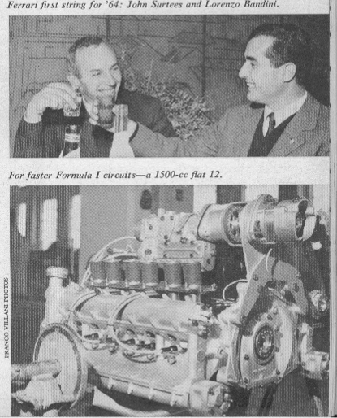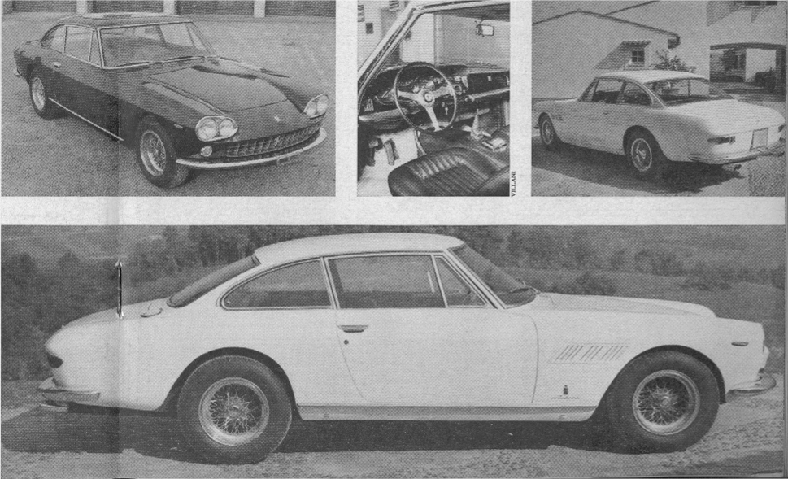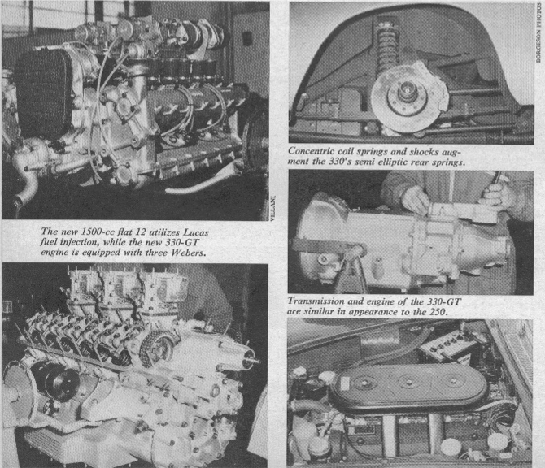 |
330 GT Registry |
 |
| FERRARI |
Il Commendatore, in an expansive |
| LOOKS AT ‘64 |
BY GRIFF BORGESON |
 The
overwhelming highlight of the latest of Ferrari’s traditional January press
meetings was the introduction of a new 4-liter car, the 330 Gran Turismo 2+2.
Still officially in production are the 250-GT 2+2, the 250 Berlinetta and the
250 Le Mans. It does seem likely that the 250 2+2 will be phased out of
production in the months ahead. And there is under development a new road
machine of very ample displacement which will be produced in extremely small
numbers.
The
overwhelming highlight of the latest of Ferrari’s traditional January press
meetings was the introduction of a new 4-liter car, the 330 Gran Turismo 2+2.
Still officially in production are the 250-GT 2+2, the 250 Berlinetta and the
250 Le Mans. It does seem likely that the 250 2+2 will be phased out of
production in the months ahead. And there is under development a new road
machine of very ample displacement which will be produced in extremely small
numbers.
The new 4-liter chassis incorporates many changes over the 3-liter but all are evolutionary. The new engine is essentially a scaled-up version of the highly satisfactory and reliable 3-liter V-12. But it is not merely a bored and stroked version of the smaller engine. Its patterns and tooling are new and a number of changes have been made in addition to those of scale. The cylinder centers are more widely spaced for improved water circulation and location of spark plugs. The water pump now is belt-driven and a 40 ampere alternator replaces the former generator. The new bore and stroke of 77 x 71 mm (3.03 x 2.80 in.) results in a swept volume of 3967 cc (244 cu in.) and a claimed output of 300 cavalli Modenese or, in SAE terms, about 325 bhp.
The transmission
components of the new chassis have been scaled up and improved. In place of the
previous single ball races the larger new transmission is fitted with double
ball races throughout. The clutch is larger and the Laycock over-drive clutch
and internal parts all have been enlarged to match their new loads. The o/d
control has been improved in a very important way. Previously, the o/d switch
was a simple on-off device. if you were in o/d and downshifted to third
(conventional, of course) and then back to top gear you found yourself back in
o/d fourth and perhaps bogging a little. With the new control, downshifting
cancels the o/d setting, thus preventing upshifts over an excessively broad
span.
The new frame is basically unchanged, is a conventional tubular structure of
electrically welded elliptical tubes. The previous rear axle housing was of
light alloy, carried 4.57 gears and was far from being silent. The new one is a
much quieter cast-iron Timken taper-roller unit with 4.25 gears. The 4-liter
engine can easily afford the small weight penalty involved.
The new car’s suspension also is evolutionary, in front there are the familiar and straightforward forged parallel wishbones. But now the coil springs are carried on pivoting cups so that they never are in bend but always are purely in compression. And the diameter of the anti-roll torsion bar has been increased from 16 to 18 mm (.63 to .71 in.).
In back, an improvement introduced on the later series of the previous 2+2 is carried over into the new one. This is the use of coil springs around the shock absorbers to bear part of the load which previously was carried by the leaf springs alone. This permits a reduction in the number of spring leaves and in inter-leaf friction. Fore and aft location of the rear axle continues to be by trailing parallel radius arms while transverse location is left to the leaf springs.
The 330’s brakes continue to be Dunlop discs, but now the front-brake calipers are aft of the wheel center-line and the assemblies are enclosed by sheet metal shrouds, both of these measures being for water protection. And now the front and rear braking systems—master cylinders, reservoirs, servos, their total circuitries—are entirely separate for fail-safe action.
The new car’s steering is by worm and peg and the king-pins are supported on needle roller bearings. The steering has the hard-to-describe feel of the work-feed wheel on a big precision lathe: utterly firm, utterly precise, yet light.
As for the 330’s styling, body-builder Scaglietti had this to say. “We all panic at every new Pininfarina design, convinced that the public never will accept it. More exciting designs come along and they usually drop dead before your eyes. But watch the 330 and see how the public likes it a few months from now. The story keeps repeating. Pininfarina has an uncanny sense for being right about what the public wants in the things that show. As for the things that go, Ing. Ferrari just keeps on pointing the way.”

One of the adjectives most commonly used in describing Commendatore Enzo Ferrari and the domain he has built is feudal. The adjective fits in its most literal sense. The Maranello plant only lacks a moat.
Once each year Ferrari holds court for the benefit of the international motoring press. It flocks to Maranello in droves although it never knows what to expect; this depends wholly upon Ing. Ferrari’s whim at the zero hour. At the latest meeting, for example, several journalists got a look at a new flat-twelve Formula I machine. Then the boss himself swept into the room, swept the visitors out, and that was that. Most of the nearly 200 journalists had to beg scraps of information from the fortunate handful who had had at least a peek at the new car.
How these meetings go depends upon such impulsive on-the-spot decisions by the sole power in this domain and by how he feels when he gets out of bed that morning. If his mood is a rough one, walk lightly. He may single out some writer who he feels has committed an act of heresy in print and, before his assembled peers, dissect and utterly crush the hapless soul with Jehovah-like wrath. Or, if his mood is bright—as it was last January 11—even deliberate taunts fail to touch him. He speaks extemporaneously with great eloquence, spiking his words with sparkling and subtle humor that is often Rabelaisian but always wholesomely so. This was his mood at the last meeting and it crowned the princely feast that he placed before his guests. And he had a great deal to communicate.
 “Our
1964 production schedule calls for the completion of three cars per day. The
250-LM Berlinetta, direct descendant of the Le Mans-winning prototype, will be
homologated. One hundred of these cars are to be completed by April and now are
under construction. Along with the improved and ever-valid 250-GTO, this will
assure our driver-clients of an effective means of repeating their performances
in the Manufacturers’ Championship, in which they already have given Ferrari two
world titles.
“Our
1964 production schedule calls for the completion of three cars per day. The
250-LM Berlinetta, direct descendant of the Le Mans-winning prototype, will be
homologated. One hundred of these cars are to be completed by April and now are
under construction. Along with the improved and ever-valid 250-GTO, this will
assure our driver-clients of an effective means of repeating their performances
in the Manufacturers’ Championship, in which they already have given Ferrari two
world titles.
“We will participate in the major races in 1964, above all in Formula I and, secondarily, in Granturismo Prototype competition. I say secondarily because it is not possible to assemble an equally strong force in both areas.
“Therefore, our official activity will not be restricted to any championship. It will take into account technical, commercial and competitive considerations and, far from least, our relationships with the individual organizers. One F-I car will be reserved for our driver-collaborator John Surtees. A second F-I car will be assigned to Lorenzo Bandini. The characteristics of these machines will be announced in the near future. During the year we will have available:
Two modified six-cylinder cars of the type which made its debut at Monza with Surtees;
Two eight-cylinder cars. The new engine is being completed very satisfactorily at this moment; and
Two twelve-cylinder cars intended for high-speed circuits.
“For UT Prototype competition we are preparing the type 275-P and 330-P cars. Their specifications will be announced before the start of the racing season.
“As for drivers, we plan to offer rides to Scarfiotti, Maglioli, Abate and Baghetti of Italy and to Guichet of France. We plan to have two official F-I drivers.
“We cannot speak of Vaccarella and Mairesse because they are not in physical condition to resume competition.
“To this activity of the company we must add that of three organizations which work closely with us: NART—the North American Racing Team—directed by Luigi Chinetti and with Pedro Rodriguez as chief driver; Maranello, Ltd., directed by Colonel Hoare, and which will have the services of Graham Hill; and the Scuderia Francorchamps, directed by Jacques Swaters, which will have the services of Lucien Bianchi.
“As for Formula II, a new car is under development. But the program visualized by the company—primarily F-I and secondarily GT Prototypes—is of such importance and of such vast technical significance that F-TI will have to wait for a later date, after we have seen its beginnings and its development in the hands of the organizers. This formula could become a very effective training ground for future drivers.
“The new F-I seems to us like a pilgrim’s return to the formula of 1921. In 1957 we proposed a 3-liter Intercontinental Formula. It had a precise objective: to invite the Americans to adhere to this maximum limit and to develop a technical interchange between racing venues in both hemispheres, above all between Indianapolis and Monza. This idea died on Italian soil. It lost to a proposal for a maximum and minimum weight regulation which was supposed to transcend intercontinental differences.
“The law of political compromise seems to dominate the International Sporting Commission of the FIA, which has not taken into account certain technical considerations which were contained in the formula which we proposed. Instead, it has preferred a mishmash which can end by ending the genuine evolution of racing technology. I would like to add that our proposal stated specifically that any change in the Indianapolis Formula by a committee of competitors and organizers must carry a three-year advance warning.
“In fact, the solutions dictated by the ‘66 formula are utterly onerous. It is not thinkable to compete in the GP of Monte Carlo with a 3-liter car of 1100 pounds and capable of 400 horsepower and more, which is suitable to Reims, Spa, Monza, etc. but is ill-adapted to a drawing-room circuit such as that of the Casino.
“The new formula presents a serious challenge to many accessory manufacturers. Tire manufacturers, for example, are going to have to find ways of coping with the problems of tires for vehicles which will be running at speeds in excess of 185 mph.
“To be ready for the starting grids in 1966 we would have to begin design and construction today. This unfortunately is not possible and thus, with the expiration of the present formula, Ferrari’s cycle of activity in Formula I racing may reach its end.
“Does racing improve the breed? Of course we believe that it does. If it does, then it is clear that after 45 years of struggle in competition we must represent an elect breed of the purest stallions.
“That racing is no mere provincial matter but is of national and international importance was demonstrated when Minister Bokanowski urged his nation’s industry to produce ‘a blue car’ which, by its racing successes, could raise the prestige of French products throughout the world.
“After the sound and fury that accompany inquiries into the utility of racing have been heard it is clear that those who answer ‘No’ do so because they are unwilling to run the risk of losing.”
Then on a note of “What can Italy do to help racing?” which was addressed to the audience, Ing. Ferrari closed his address.
The first questioner asked the nature of the Italian government’s present help to firms such as Ferrari’s. It goes so far as to make available loans at high rates of interest. Period.
Next, how about Fiat? Doesn’t Fiat underwrite Ferrari or own a big chunk of Ferrari? This was a sharply driven needle that failed to draw blood. Ing. Ferrari replied with emphatic calm that nobody owns any part of his business. it stands proudly, aggressively, free and alone.
Next, how about the American challenge in the field of light-weight construction? The Commendatore knew of no such challenge, it exists in the sports car field, he was told. He replied that sports car racing survives only on a provincial level and therefore is beyond his interest or concern.
How about Granturismo competition? he was asked. “You can say,” he replied with an open laugh, “that the Americans have us whipped. We just don’t have those whopping engines.”
And how about the long dreamed-of autodrome for Modena? “Well,” he replied, “that is a fantastically costly project. We’d have to have the nightly earnings of Miss X (naming Italy’s Number One party girl) before we could consider it, and we’re not that lucky.”
“Don’t you think
we’ve had enough talk?” the host said. Between the end less courses of
gastronomic riches awards were made on behalf of the host. Among the recipients
were all of Italy’s best drivers, plus Surtees, Graham Hill, and Mike Parkes,
who is responsible for the design and development of Ferrari passenger, GT and
prototype cars. Special awards went to Chinetti, Rodriguez and Pabst.
ROAD & TRACK APRIL 1964
Copyright 1964 John R. Bond, Inc.
